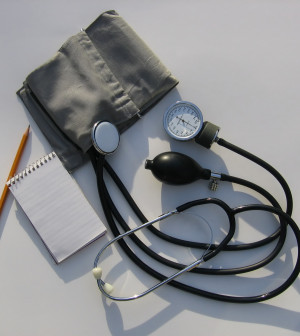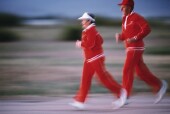- Navigating Your Midlife Crisis: Embracing New Possibilities
- City Raccoons Showing Signs of Domestication
- Mapping the Exposome: Science Broadens Focus to Environmental Disease Triggers
- One Week Less on Social Media Linked to Better Mental Health
- Your Brain Changes in Stages as You Age, Study Finds
- Some Suicide Victims Show No Typical Warning Signs, Study Finds
- ByHeart Formula Faces Lawsuits After Babies Sickened With Botulism
- Switch to Vegan Diet Could Cut Your Greenhouse Gas Emissions in Half
- Regular Bedtime Does Wonders for Blood Pressure
- Dining Alone Could Mean Worse Nutrition for Seniors
Fit at 50? Cardiac Arrest During Exercise Unlikely, Study Finds


Physically active middle-aged men and women have little chance of suffering cardiac arrest while playing sports, a new study suggests.
Researchers reviewed more than 1,200 cases of sudden cardiac arrest — abrupt loss of heart function — among adults aged 35 to 65. They found only 5 percent of attacks occurred during sports activity such as jogging or bicycling.
And the outcome for those patients was positive, the researchers said.
“When you take a closer look at those who have a sports-related cardiac arrest, they were more likely to survive than those whose cardiac arrest was not sports-related,” said lead researcher Dr. Sumeet Chugh, associate director of genomic cardiology at Cedars-Sinai Heart Institute in Los Angeles.
“Overall, the news is good. The risk of dying suddenly if you participate in sports is quite low,” Chugh said.
However, if you have a known heart problem, any heart symptoms or are a “total couch potato,” you might want to see your doctor before starting any significant sports activity, he added.
Dr. Gregg Fonarow, a professor of cardiology at the University of California, Los Angeles, said the findings shore up recommendations that adults should get regular exercise.
For the report, published online April 6 in the journal Circulation, Chugh’s team reviewed almost 1,250 cases of sudden cardiac arrest among middle-aged adults from the Oregon Sudden Unexpected Death Study. Patients’ average age was 51.
They looked to see how many were stricken during physical activity (sexual activity was not included).
Of the 5 percent of cases suffered during exercise, more than one-quarter took place while jogging. Basketball and cycling accounted for fewer than one in five sports-related cardiac arrests, the study found.
The attacks didn’t occur entirely out of the blue. More than one-third had symptoms of heart disease, such as chest pain or breathlessness, in the week before their heart stopped, and more than half had risk factors for heart disease, the study found.
Sports participation made it more likely the person would be seen and treated, the researchers found. Close to 90 percent of sports-associated cardiac arrests were witnessed — often because they occurred at a gym or other public place — versus roughly half of those that occurred at other times. Those people were also more likely to receive CPR — 44 percent versus 25 percent. (CPR increases the odds of survival.)
Moreover, fit men and women were more likely to survive than unfit folks (23 percent versus 14 percent).
Many more men had sports-associated sudden cardiac arrest than women, possibly because they are more likely to engage in sports, Chugh said.
Fonarow said that although vigorous activity may increase the risk of sudden cardiac death and heart attack in potentially susceptible people, it should be encouraged in the general population.
“Regular physical activity is recommended as an important means to improve heart health and reduce the risk of heart attacks, sudden cardiac death and stroke,” he said.
This new report finds that sports-associated sudden cardiac arrest in middle-aged adults occurred relatively infrequently, compared with the overall frequency in the communities studied, Fonarow said.
“Further, many individuals that had sudden cardiac death had risk factors or symptoms suggesting increased risk,” he said.
Careful attention to pre-existing disease or warning signs is key, the experts agreed.
More information
For more on heart health and exercise, visit the U.S. National Institutes of Health.
Source: HealthDay
Copyright © 2025 HealthDay. All rights reserved.










